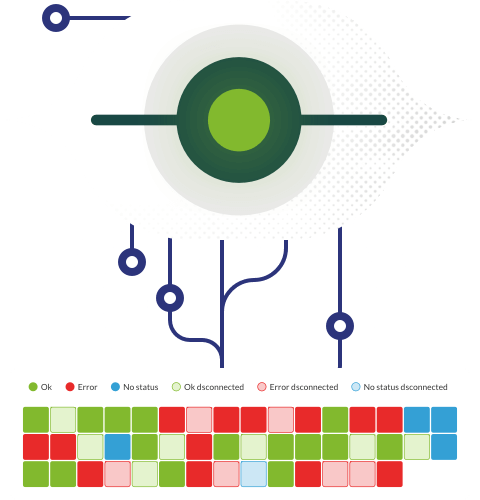Below, we explore its impact and how its legacy continues to influence today’s technology.
Computing history is filled with revolutionary milestones, and among them, the ENIAC (Electronic Numerical Integrator and Computer) holds a special place. Built in the 1940s, this electronic giant marked the beginning of digital computing as we know it today. But what impact did it have on modern technology, and how does it relate to monitoring solutions like Pandora FMS? Let’s find out.
What Was ENIAC?
ENIAC was the first general-purpose, fully digital computer. Designed by John Presper Eckert and John William Mauchly at the University of Pennsylvania in 1943, its primary goal was to calculate ballistic trajectories for the U.S. Army during World War II.
The U.S. government funded the project with approximately $500,000 at the time, equivalent to about $9,337,426 million today. Its development took three years and culminated in its operational launch in 1946. From its very first day of operation, ENIAC demonstrated its ability to perform complex calculations at unprecedented speeds.
Main Features of ENIAC
- Colossal Dimensions: ENIAC occupied 1,800 square feet and weighed approximately 27 tons. It was one of the largest computers built at the time, spanning a vast room. Its size and weight were due to the enormous number of electronic components used, requiring a robust infrastructure to support and maintain its operation.
- Advanced Components for the Time: ENIAC featured 17,468 vacuum tubes, 70,000 resistors, 10,000 capacitors, and 7,200 crystal diodes. Each vacuum tube functioned as an electronic switch, allowing circuits to perform logical operations. However, due to the rudimentary technology of the time, the tubes would heat up quickly and frequently fail, requiring constant replacements and extensive maintenance.
- Computational Power: ENIAC could perform 5,000 additions or 300 multiplications per second. While this is insignificant compared to any modern smartphone, at the time, it revolutionized computing and enabled calculations that previously took weeks.
- Digital Structure: Unlike its analog predecessors, ENIAC operated entirely digitally. Instead of using mechanical or electromagnetic methods to represent data, ENIAC used electrical pulses to manipulate information in binary (1s and 0s). This shift allowed for more reliable operation and laid the foundation for modern computer design.
- Complex Programming: To program ENIAC, its operators had to manipulate more than 6,000 switches and physically connect a network of cables. Each new task required a manual reconfiguration, which could take days or even weeks. This process was tedious and prone to errors, driving the development of new programming languages and process automation.
- High Heat Generation: Due to its large number of vacuum tubes, ENIAC generated an enormous amount of heat, raising the room temperature to extreme levels. To prevent overheating, advanced ventilation systems had to be installed, and at times, doors and windows had to be opened to dissipate the heat. This increased operational costs and presented additional maintenance challenges.
- Autonomy and Frequent Failures: Although it could operate autonomously for long periods, vacuum tube failures were common. It is estimated that one or more of these valves would fail every 48 hours, interrupting the system’s operation. To reduce these issues, engineers discovered that keeping the machine running continuously decreased the frequency of failures.
From ENIAC to Monitoring with Pandora FMS
System monitoring has come a long way since ENIAC. In its time, tracking this computing behemoth’s performance depended on manual measurements and constant technical adjustments. Today, advanced solutions like Pandora FMS enable automated IT infrastructure monitoring, anticipating problems before they occur.
Before vs. Now
|
ENIAC (1946) |
Modern Monitoring |
|
Manual supervision by technicians |
Real-time automated monitoring |
|
Physical failure analysis |
Automatic alerts and predictive detection |
|
Centralized, local hardware |
Distributed and cloud-based infrastructure |
How Has Monitoring Evolved?
- From Manual to Automatic: In ENIAC’s time, failure detection relied entirely on technical personnel, who had to physically inspect components and replace defective ones. Today, monitoring systems can identify problems in real-time, issuing automatic alerts so IT teams can act immediately. This minimizes downtime and optimizes the performance of technological infrastructures.
- From Hardware to Software: While ENIAC-era supervision focused on hardware, ensuring the proper functioning of vacuum tubes and electrical connections, modern monitoring is software-driven. Today, it’s possible to analyze the performance of servers, databases, applications, and networks from a single dashboard, identifying bottlenecks and ensuring optimal service operation.
- From Local Systems to Distributed Environments: ENIAC operated in an isolated, closed environment, requiring a team of experts to be physically present for adjustments and repairs. In contrast, modern monitoring platforms like Pandora FMS enable remote IT infrastructure management, overseeing cloud systems, hybrid environments, and global networks from a single platform.
Pandora FMS: Advanced Monitoring for the Digital Era
If ENIAC marked the beginning of digital computing, tools like Pandora FMS have taken its legacy to a whole new level. With features such as:
- Real-time System Monitoring: Pandora FMS enables real-time data collection and analysis, helping businesses anticipate issues before they impact system performance. This is essential for ensuring the availability of critical services and minimizing disruptions.
- Automatic Alerts to Prevent Failures: With intelligent notification systems, Pandora FMS sends alerts via email, SMS, or integrations with IT management tools when it detects anomalies in the system. This allows support teams to respond quickly and prevent prolonged downtime.
- Infrastructure Management from Anywhere: Unlike ENIAC’s era, when monitoring required the physical presence of technicians, Pandora FMS enables global infrastructure management through a centralized web interface, regardless of the administrative team’s physical location.
- Predictive Analysis to Optimize Performance: Using artificial intelligence and big data, Pandora FMS can analyze historical patterns and predict potential failures before they occur. This allows businesses to conduct proactive maintenance and optimize resource utilization.
Conclusion
The evolution from ENIAC to modern monitoring platforms like Pandora FMS demonstrates the unstoppable advancement of technology. Today, businesses can anticipate problems and manage IT infrastructures with unprecedented efficiency. Real-time data collection, automated failure detection, and resource optimization enable organizations of all sizes to enhance performance and avoid costly downtime.
As technology continues to evolve, monitoring becomes more crucial than ever. The complexity of modern systems demands solutions that not only detect problems but also help predict and prevent incidents before they impact operations. Pandora FMS is a key tool in this process, providing businesses with the ability to adapt to the challenges of the digital world and ensure the efficient operation of their systems.
Don’t miss out! Try Pandora FMS free trial version now and discover how it can transform your IT infrastructure management and monitoring. Download it here: Free Pandora FMS Trial.
Pandora FMS’s editorial team is made up of a group of writers and IT professionals with one thing in common: their passion for computer system monitoring. Pandora FMS’s editorial team is made up of a group of writers and IT professionals with one thing in common: their passion for computer system monitoring.


















